Anchor Loss Reduction of Lamb Wave Resonator by Pillar-Based Phononic Crystal
Abstract
:1. Introduction
2. Design of the Phononic Crystal Anchors
2.1. Dispersion Relations
2.2. Optimization of Phononic Crystal
2.3. Transmission Spectra
3. Lamb Wave Resonator Design and Finite Element Analysis
4. Results and Discussion
5. Conclusions
Author Contributions
Funding
Conflicts of Interest
References
- Zhang, Q.; Han, T.; Tang, G.; Chen, J.; Hashimoto, K.-Y. SAW characteristics of AlN/SiO 2/3C-SiC layered structure with embedded electrodes. IEEE Trans. Ultrason. Ferroelectr. Freq. Control 2016, 63, 1608–1612. [Google Scholar] [CrossRef] [PubMed]
- Zou, J.; Lin, C.-M.; Pisano, A.P. Quality Factor Enhancement in Lamb Wave Resonators Utilizing Butterfly-Shaped AlN Plates. In Proceedings of the 2014 IEEE International Ultrasonics Symposium, Chicago, IL, USA, 3–6 September 2014; pp. 81–84. [Google Scholar]
- Liu, Y.; Cai, Y.; Zhang, Y.; Tovstopyat, A.; Liu, S.; Sun, C. Materials, Design, and Characteristics of Bulk Acoustic Wave Resonator: A Review. Micromachines 2020, 11, 630. [Google Scholar] [CrossRef] [PubMed]
- Lin, C.-M.; Lai, Y.-J.; Hsu, J.-C.; Chen, Y.-Y.; Senesky, D.G.; Pisano, A.P. High-Q aluminum nitride Lamb wave resonators with biconvex edges. Appl. Phys. Lett. 2011, 99, 143501. [Google Scholar] [CrossRef] [Green Version]
- Zou, J.; Liu, J.; Tang, G. Transverse spurious mode compensation for AlN Lamb wave resonators. IEEE Access 2019, 7, 67059–67067. [Google Scholar] [CrossRef]
- Lin, C.-M.; Yen, T.-T.; Lai, Y.-J.; Felmetsger, V.V.; Hopcroft, M.A.; Kuypers, J.H.; Pisano, A.P. Temperature-compensated aluminum nitride Lamb wave resonators. IEEE Trans. Ultrason. Ferroelectr. Freq. Control 2010, 57, 524–532. [Google Scholar] [PubMed]
- Segovia-Fernandez, J.; Cremonesi, M.; Cassella, C.; Frangi, A.; Piazza, G. Experimental Study on the Impact of Anchor Losses on the Quality Factor of Contour Mode AlN Resonators. In Proceedings of the 2013 Transducers & Eurosensors XXVII: The 17th International Conference on Solid-State Sensors, Actuators and Microsystems, Barcelona, Spain, 16–20 June 2013; pp. 2473–2476. [Google Scholar]
- Frangi, A.; Cremonesi, M.; Jaakkola, A.; Pensala, T. Analysis of anchor and interface losses in piezoelectric MEMS resonators. Sens. Actuators A Phys. 2013, 190, 127–135. [Google Scholar] [CrossRef]
- Bindel, D.S.; Govindjee, S. Elastic PMLs for resonator anchor loss simulation. Int. J. Numer. Methods Eng. 2005, 64, 789–818. [Google Scholar] [CrossRef]
- Siddiqi, M.W.U.; Fedeli, P.; Tu, C.; Frangi, A.; Lee, J.E. Numerical analysis of anchor loss and thermoelastic damping in piezoelectric AlN-on-Si Lamb wave resonators. J. Micromech. Microeng. 2019, 29, 105013. [Google Scholar] [CrossRef]
- Pandey, M.; Reichenbach, R.B.; Zehnder, A.T.; Lal, A.; Craighead, H.G. Reducing anchor loss in MEMS resonators using mesa isolation. J. Microelectromech. Syst. 2009, 18, 836–844. [Google Scholar] [CrossRef]
- Ardito, R.; Cremonesi, M.; D’Alessandro, L.; Frangi, A. Application of Optimally-Shaped Phononic Crystals to Reduce Anchor Losses of MEMS Resonators. In Proceedings of the 2016 IEEE International Ultrasonics Symposium, Tours, France, 18–21 September 2016; pp. 1–3. [Google Scholar]
- Cassella, C.; Segovia-Fernandez, J.; Piazza, G.; Cremonesi, M.; Frangi, A. Reduction of Anchor Losses by Etched Slots in Aluminum Nitride Contour Mode Resonators. In Proceedings of the 2013 Joint European Frequency and Time Forum & International Frequency Control Symposium, Pargue, Czech Republic, 21–25 July 2013; pp. 926–929. [Google Scholar]
- Harrington, B.; Abdolvand, R. In-plane acoustic reflectors for reducing effective anchor loss in lateral–extensional MEMS resonators. J. Micromech. Microeng. 2011, 21, 085021. [Google Scholar] [CrossRef]
- Van Beek, J.; Puers, R. A review of MEMS oscillators for frequency reference and timing applications. J. Micromech. Microeng. 2011, 22, 013001. [Google Scholar] [CrossRef]
- Zafar, L.R.; Huang, J.; Khan, M.A. Quality enhancement and insertion loss reduction of a rectangular resonator by employing an ultra-wide band gap diamond phononic crystal. Chin. J. Phys. 2020, 65, 481–490. [Google Scholar] [CrossRef]
- Hsu, J.-C.; Hsu, F.-C.; Huang, T.-C.; Wang, C.-H.; Chang, P. Reducing Anchor Loss in Micromechanical Resonators Using Phononic Crystal Strips. In Proceedings of the 2011 IEEE International Ultrasonics Symposium, Orlando, FL, USA, 18–21 October 2011; pp. 2483–2486. [Google Scholar]
- Lin, C.-M.; Hsu, J.-C.; Senesky, D.G.; Pisano, A.P. Anchor Loss Reduction in AlN Lamb Wave Resonators Using Phononic Crystal Strip Tethers. In Proceedings of the 2014 IEEE International Frequency Control Symposium, Taipei, Taiwan, 19–22 May 2014; pp. 1–5. [Google Scholar]
- Bao, F.-H.; Wu, X.-Q.; Zhou, X.; Wu, Q.-D.; Zhang, X.-S.; Bao, J.-F. Spider web-like phononic crystals for piezoelectric MEMS resonators to reduce acoustic energy dissipation. Micromachines 2019, 10, 626. [Google Scholar] [CrossRef] [PubMed] [Green Version]
- Kuo, N.-K.; Zuo, C.; Piazza, G. Microscale inverse acoustic band gap structure in aluminum nitride. Appl. Phys. Lett. 2009, 95, 093501. [Google Scholar] [CrossRef] [Green Version]
- Oseev, A.; Lucklum, R.; Zubtsov, M.; Schmidt, M.-P.; Mukhin, N.V.; Hirsch, S. SAW-Based Phononic Crystal Microfluidic Sensor—Microscale Realization of Velocimetry Approaches for Integrated Analytical Platform Applications. Sensors 2017, 17, 2187. [Google Scholar] [CrossRef] [Green Version]
- Maurin, F.; Claeys, C.; Deckers, E.; Desmet, W. Probability that a band-gap extremum is located on the irreducible Brillouin-zone contour for the 17 different plane crystallographic lattices. Int. J. Solids Struct. 2018, 135, 26–36. [Google Scholar] [CrossRef]
- Song, A.; Wang, X.; Chen, T.; Jiang, P.; Bao, K. Low-frequency bandgaps of two-dimensional phononic crystal plate composed of asymmetric double-sided cylinder stubs. Int. J. Mod. Phys. B 2016, 30, 1650029. [Google Scholar] [CrossRef]
- Siddiqi, M.W.U.; Lee, J.E.-Y. Wide acoustic bandgap solid disk-shaped phononic crystal anchoring boundaries for enhancing quality factor in AlN-on-Si MEMS resonators. Micromachines 2018, 9, 413. [Google Scholar] [CrossRef] [Green Version]
- Bao, F.-H.; Bao, J.-F.; Lee, J.E.-Y.; Bao, L.-L.; Khan, M.A.; Zhou, X.; Wu, Q.-D.; Zhang, T.; Zhang, X.-S. Quality factor improvement of piezoelectric MEMS resonator by the conjunction of frame structure and phononic crystals. Sens. Actuators A Phys. 2019, 297, 111541. [Google Scholar] [CrossRef]
- Otsuka, P.H.; Danworaphong, S.; Veres, I.; Wright, O.B.; Chinbe, R.; Tomoda, M.; Tanaka, Y.; Kim, S.H.; Matsuda, O.; Jeon, H.S. Confinement of Acoustic Fields in a Honeycomb Phononic Crystal Slab. In Proceedings of the 2019 5th International Conference on Engineering, Applied Sciences and Technology, Luang Prabang, Laos, 2–5 July 2019; pp. 1–3. [Google Scholar]
- Ronda, S.; Aragón, J.L.; Iglesias, E.; Montero de Espinosa, F. The use of phononic crystals to design piezoelectric power transducers. Sensors 2017, 17, 729. [Google Scholar] [CrossRef] [Green Version]
- Anufriev, R.; Nomura, M. Phonon and heat transport control using pillar-based phononic crystals. Sci. Technol. Adv. Mater. 2018, 19, 863–870. [Google Scholar] [CrossRef] [PubMed] [Green Version]
- Ma, C.; Guo, J.; Liu, Y. Extending and lowing band gaps in one-dimensional phononic crystal strip with pillars and holes. J. Phys. Chem. Solids 2015, 87, 95–103. [Google Scholar] [CrossRef]
- Laude, V. Phononic Crystals: Artificial Crystals for Sonic, Acoustic, and Elastic Waves; Walter de Gruyter GmbH & Co KG: Berlin, Germany, 2015; Volume 26. [Google Scholar]
- Baboly, M.G.; Su, M.; Reinke, C.; Alaie, S.; Goettler, D.; El-Kady, I.; Leseman, Z. The effect of stiffness and mass on coupled oscillations in a phononic crystal. AIP Adv. 2013, 3, 112121. [Google Scholar] [CrossRef] [Green Version]
- Mohammadi, S.; Eftekhar, A.A.; Adibi, A. Large Simultaneous Band Gaps for Photonic and Phononic Crystal Slabs. In Proceedings of the Conference on Lasers and Electro-Optics, San Jose, CA, USA, 4–9 May 2008. [Google Scholar]
- Khelif, A.; Achaoui, Y.; Benchabane, S.; Laude, V.; Aoubiza, B. Locally resonant surface acoustic wave band gaps in a two-dimensional phononic crystal of pillars on a surface. Phys. Rev. B 2010, 81, 214303. [Google Scholar] [CrossRef] [Green Version]
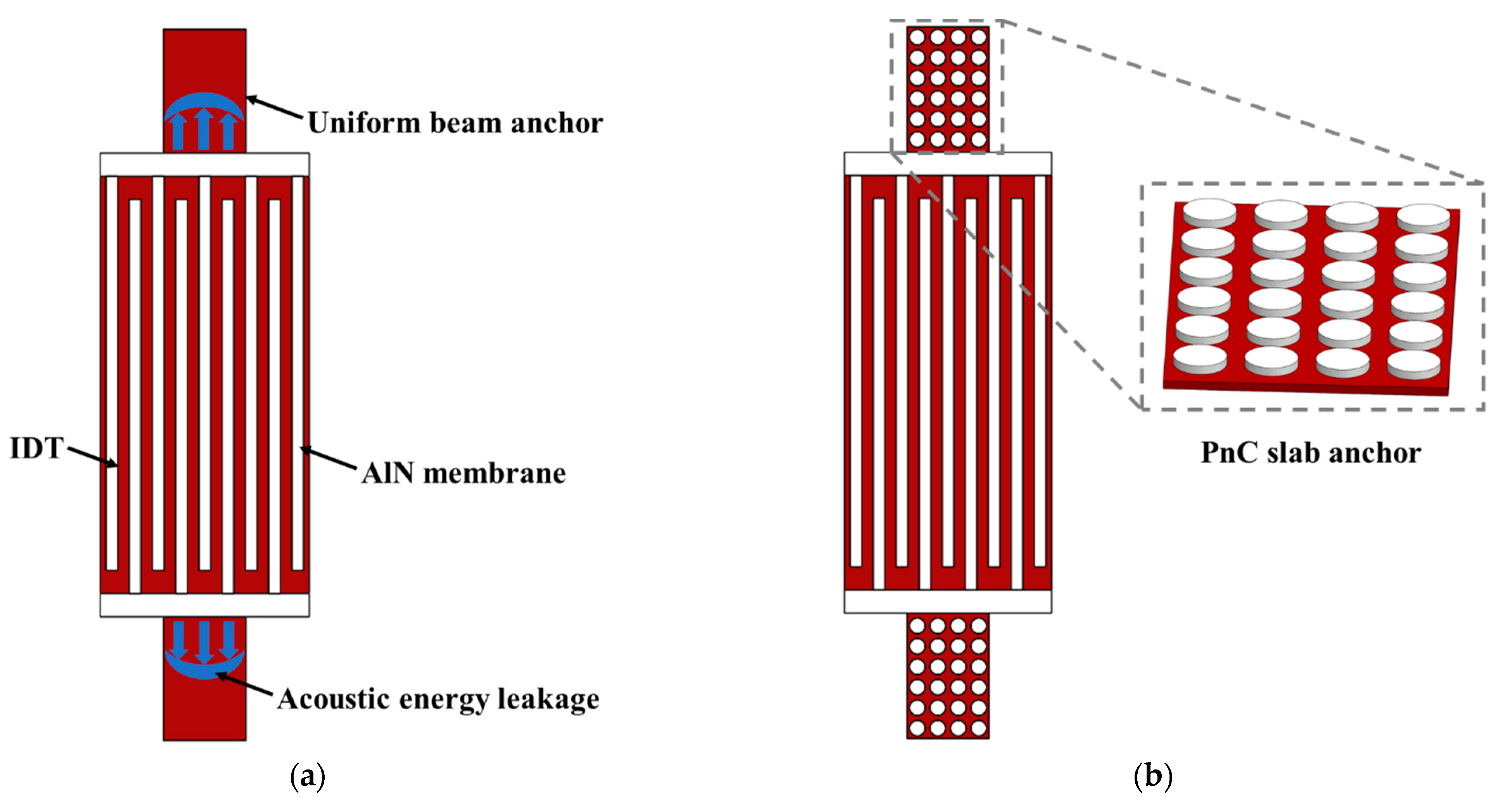
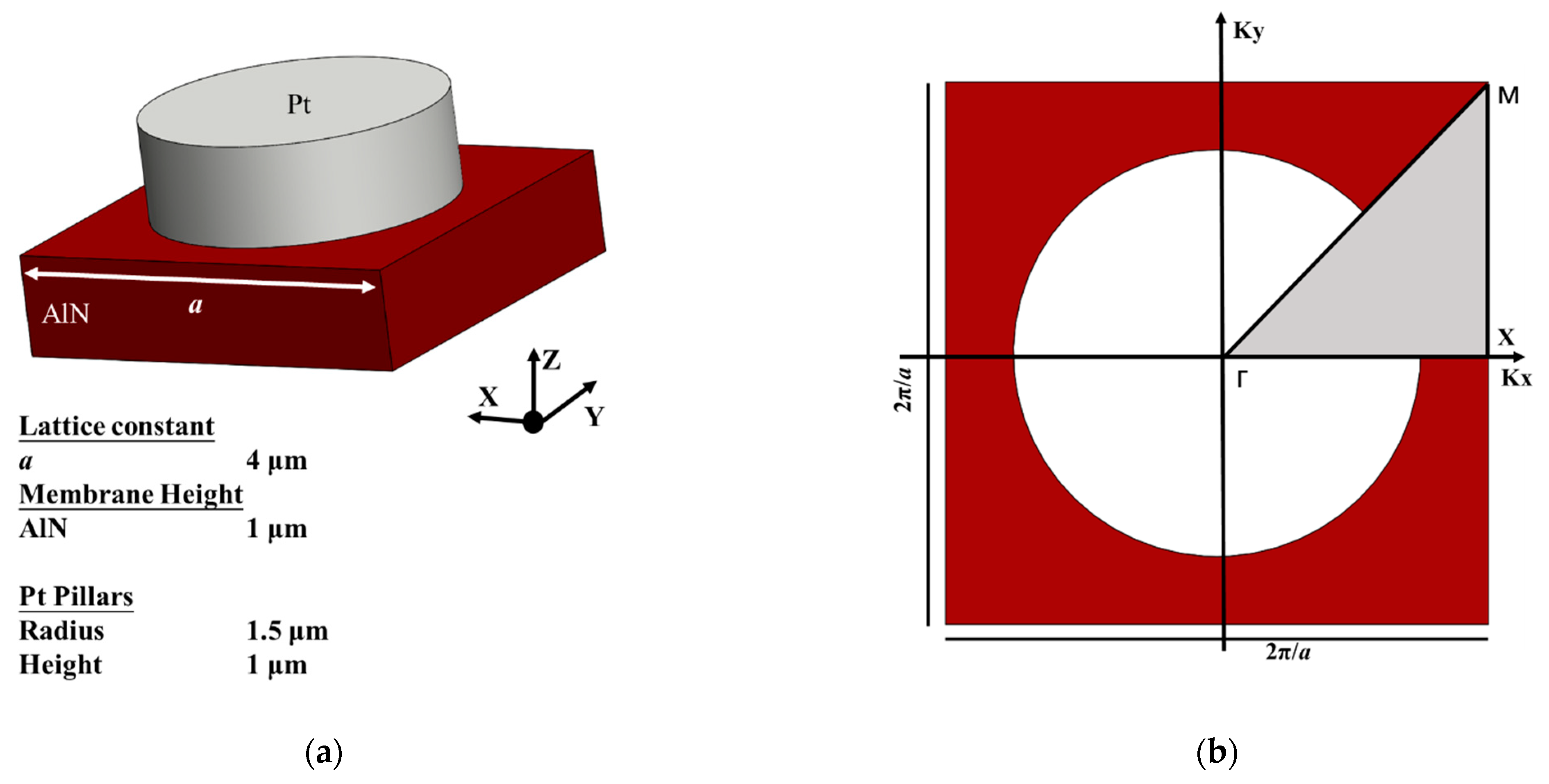
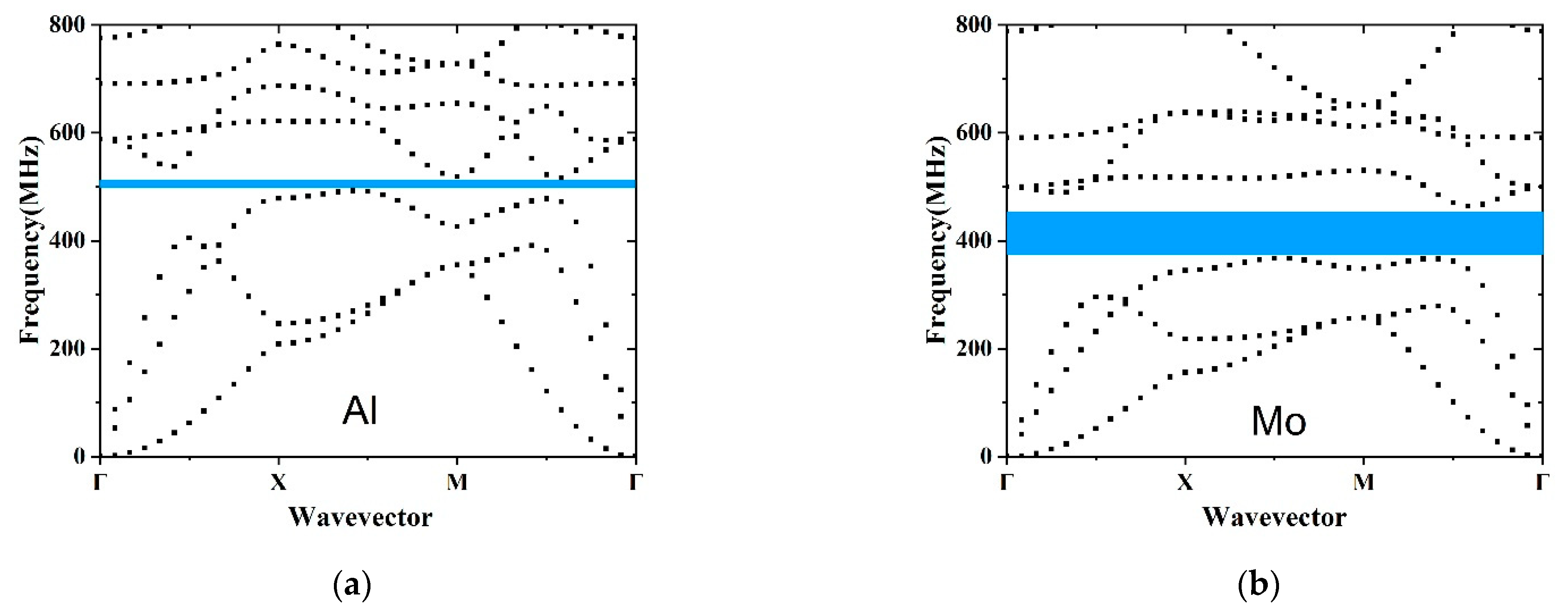
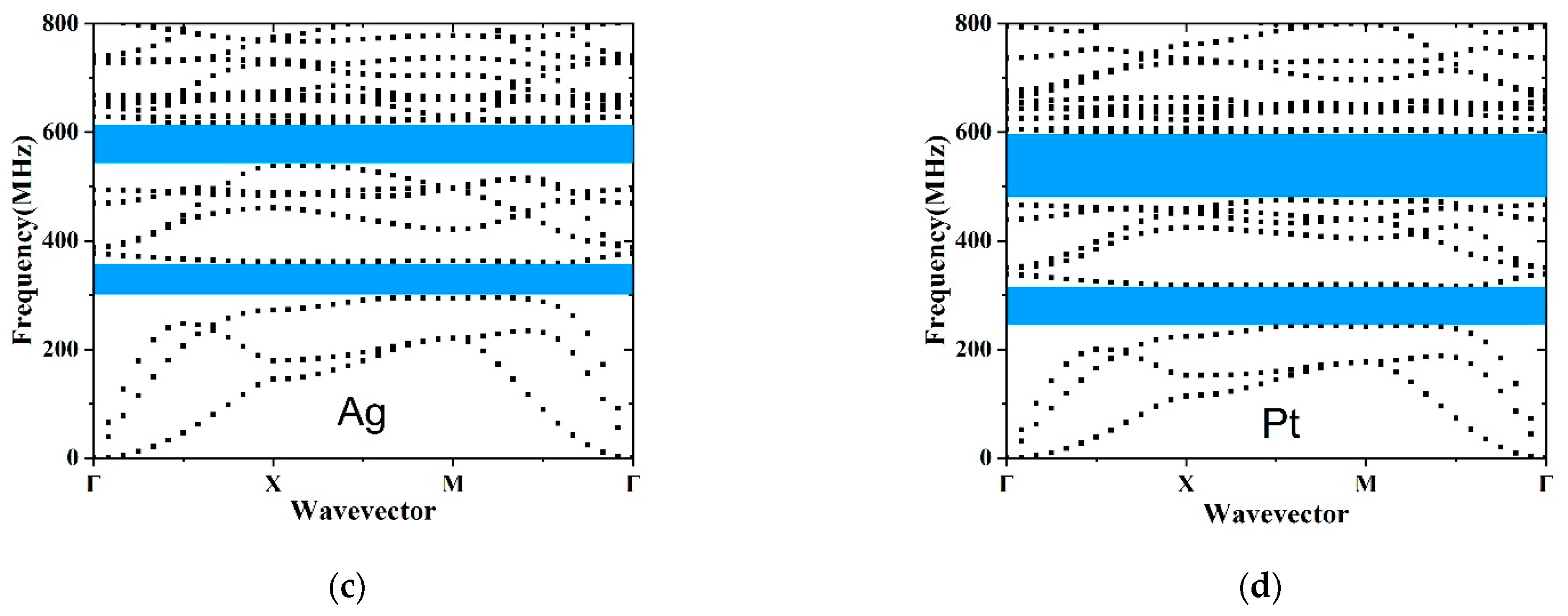

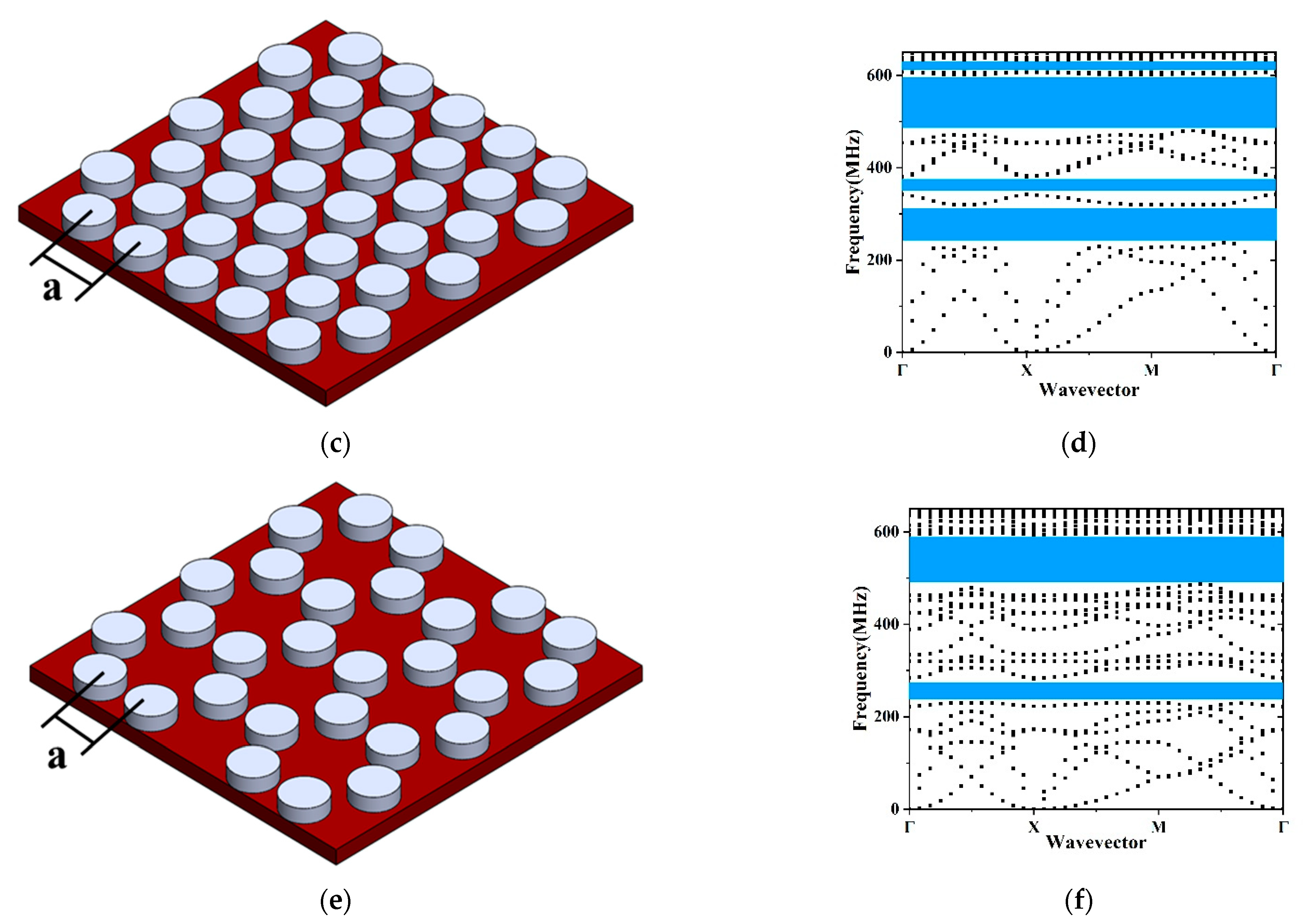
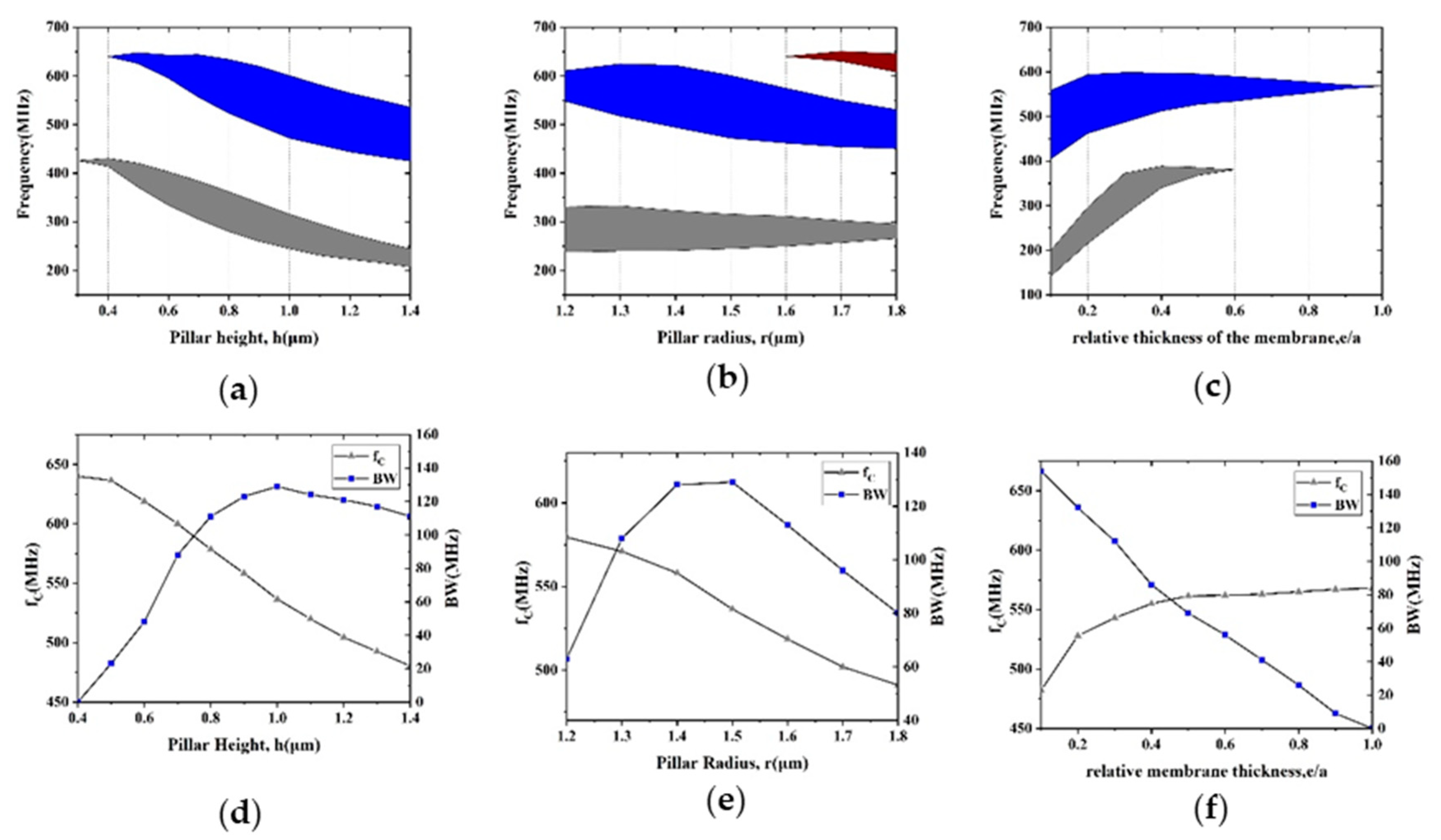
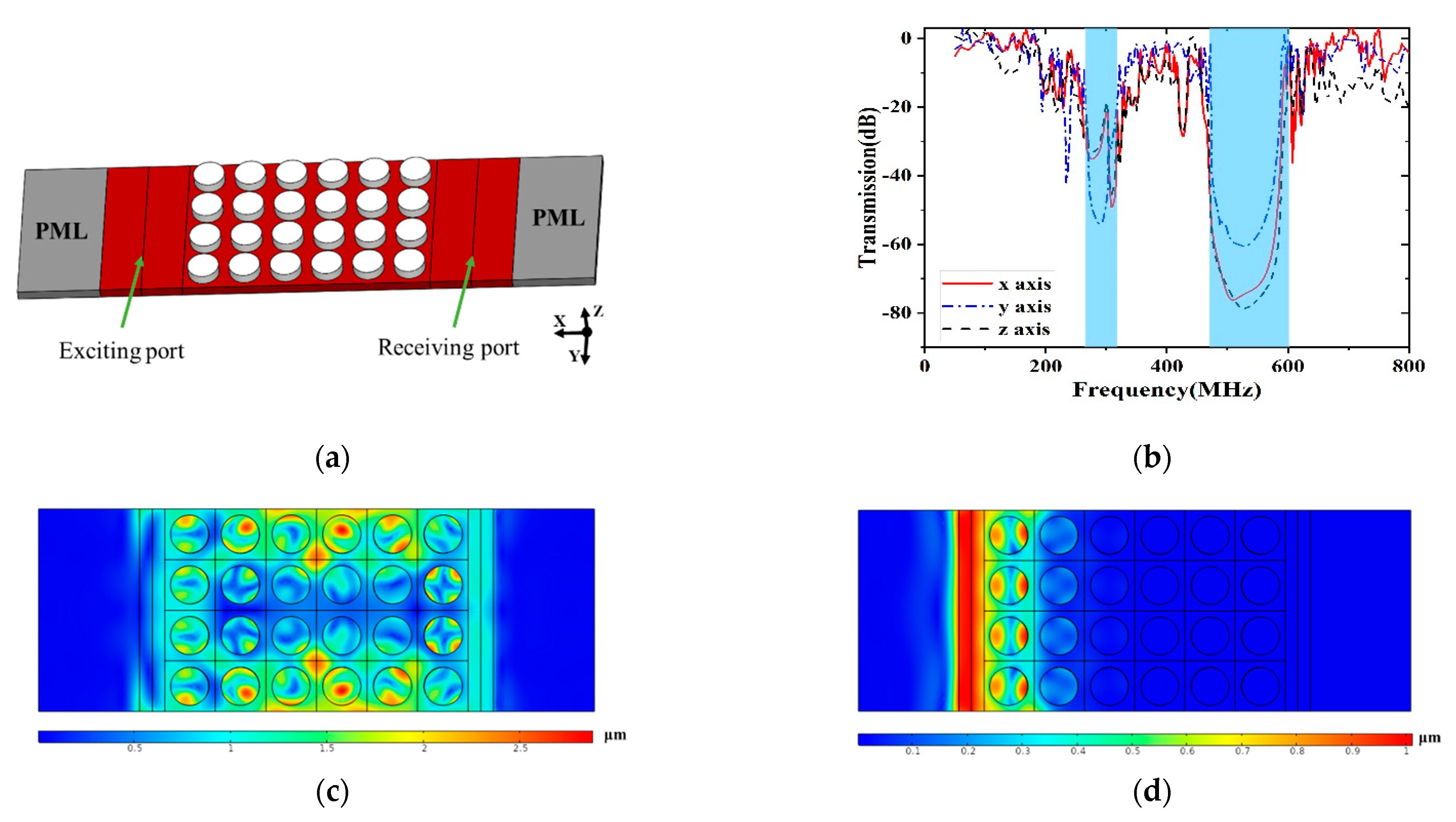
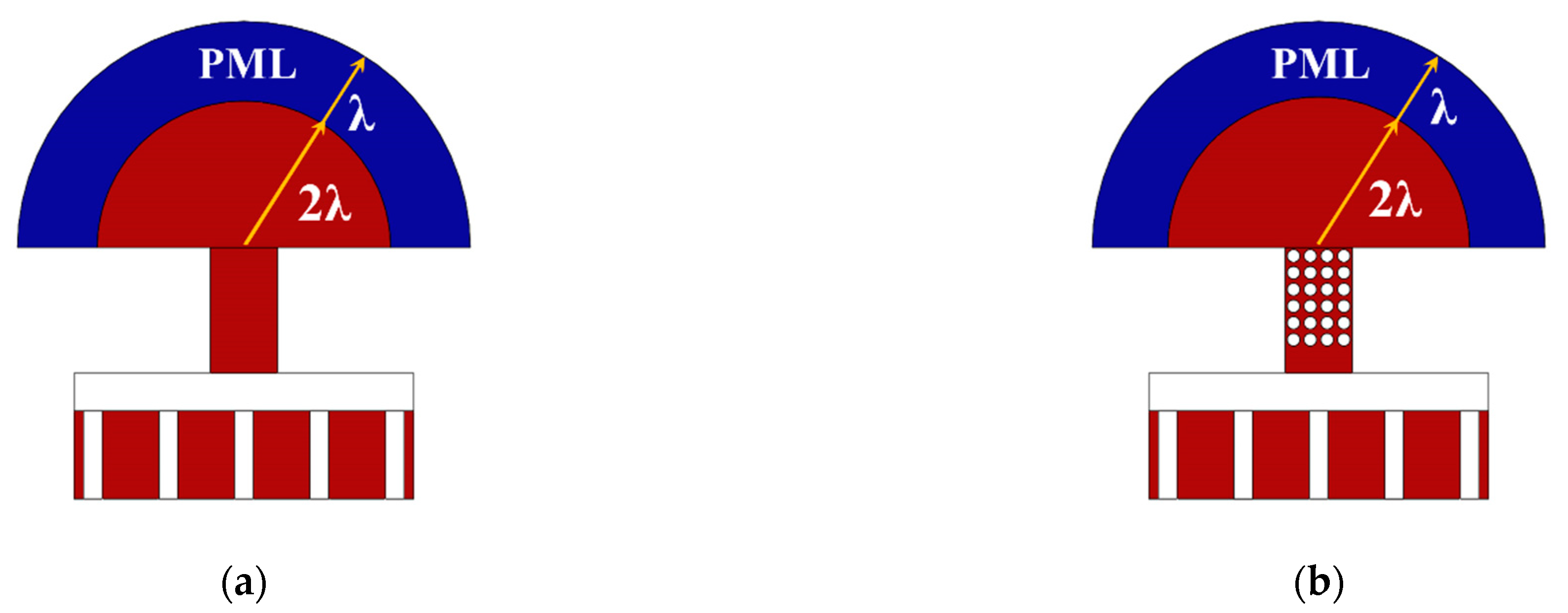
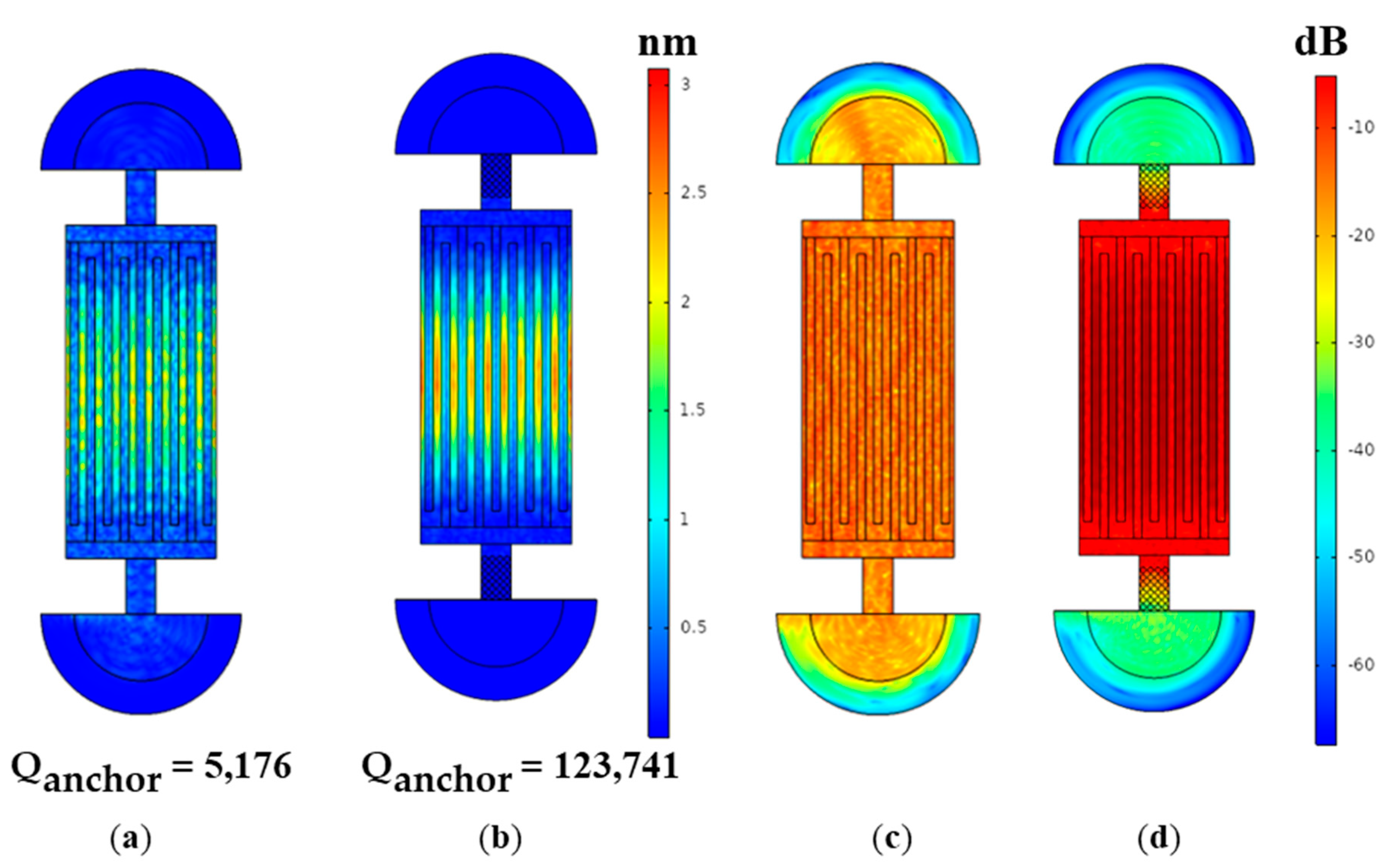

| Material | Mass Density (kg/m3) | Young’s Modulus (GPa) |
|---|---|---|
| Aluminum nitride (AlN) | 3260 | 340 |
| Aluminum (Al) | 2700 | 70 |
| Molybdenum (Mo) | 10,200 | 330 |
| Silver (Ag) | 10,500 | 83 |
| Platinum (Pt) | 21,450 | 168 |
| Parameters | Values |
|---|---|
| Inter digitated transducer (IDT) finger | 9 |
| Electrode pitch (μm) | 9 |
| Metal ratio | 0.5 |
| Aperture (μm) | 180 |
| Anchor length (μm) | 30 |
| Anchor width (μm) | 16 |
Publisher’s Note: MDPI stays neutral with regard to jurisdictional claims in published maps and institutional affiliations. |
© 2021 by the authors. Licensee MDPI, Basel, Switzerland. This article is an open access article distributed under the terms and conditions of the Creative Commons Attribution (CC BY) license (http://creativecommons.org/licenses/by/4.0/).
Share and Cite
Tong, Y.; Han, T. Anchor Loss Reduction of Lamb Wave Resonator by Pillar-Based Phononic Crystal. Micromachines 2021, 12, 62. https://doi.org/10.3390/mi12010062
Tong Y, Han T. Anchor Loss Reduction of Lamb Wave Resonator by Pillar-Based Phononic Crystal. Micromachines. 2021; 12(1):62. https://doi.org/10.3390/mi12010062
Chicago/Turabian StyleTong, Yinjie, and Tao Han. 2021. "Anchor Loss Reduction of Lamb Wave Resonator by Pillar-Based Phononic Crystal" Micromachines 12, no. 1: 62. https://doi.org/10.3390/mi12010062




